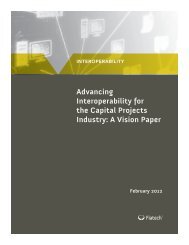An Introduction to ISO 15926 November 2011 - iRINGToday
An Introduction to ISO 15926 November 2011 - iRINGToday
An Introduction to ISO 15926 November 2011 - iRINGToday
You also want an ePaper? Increase the reach of your titles
YUMPU automatically turns print PDFs into web optimized ePapers that Google loves.
V<br />
02<br />
45<br />
V<br />
03<br />
44<br />
V<br />
04<br />
V<br />
05<br />
43<br />
V<br />
01<br />
27<br />
28<br />
26<br />
12<br />
11<br />
25<br />
24<br />
10<br />
8<br />
9<br />
EPC 2<br />
13<br />
EPC 1<br />
19<br />
20<br />
22 14 21 33<br />
2<br />
15<br />
23<br />
17<br />
1<br />
V<br />
10<br />
18<br />
16<br />
3<br />
V<br />
11<br />
4<br />
Owner<br />
38<br />
37<br />
42<br />
32<br />
41<br />
6<br />
7<br />
5<br />
Const<br />
1<br />
Const<br />
2<br />
Const<br />
3<br />
29<br />
34<br />
35<br />
36<br />
39<br />
40<br />
30<br />
31<br />
V<br />
20<br />
V<br />
21<br />
V<br />
22<br />
V<br />
30<br />
V<br />
31<br />
Fig 1.13 One owner, two engineers, and three construc<strong>to</strong>rs.<br />
Overall, there are 18 players with 45 different connections between them. Remember that<br />
each colored line in Figure 1.13 represents a separate mapping project involving hundreds or,<br />
in the case of the EPC contrac<strong>to</strong>r-<strong>to</strong>-owner transfer, thousands of data-point maps. Of course,<br />
no one would ever do this.<br />
Even if the owner were willing <strong>to</strong> pay for all cus<strong>to</strong>m database maps (either explicitly or built<br />
in<strong>to</strong> the prices), the speed with which the maps would have <strong>to</strong> be created would be prohibitive.<br />
Once an owner signs an agreement <strong>to</strong> begin detailed engineering, there is no time <strong>to</strong><br />
spare. The requirement that all bidders agree <strong>to</strong> a database mapping exercise before submitting<br />
bids delays a project significantly.<br />
Wouldn’t it be nice if the whole world would agree on a common manner of describing plant<br />
objects and a common set of definitions? Then we could just tell each other “Have your<br />
machine talk <strong>to</strong> my machine.” If all participants map their databases <strong>to</strong> a common standard,<br />
everyone only has <strong>to</strong> map their applications once—ever.<br />
We Need a Babel Fish<br />
To reuse a metaphor, we need a Babel fish (Figure 1.14) <strong>to</strong> translate information from one company<br />
<strong>to</strong> another. Fortunately, <strong>ISO</strong> <strong>15926</strong> acts very much like a Babel fish.<br />
• Each company creates its own <strong>ISO</strong> <strong>15926</strong> interface and makes it available <strong>to</strong> its business<br />
partners.<br />
• Each company maps its own database (or at any rate, those portions of its database it<br />
wishes <strong>to</strong> publish <strong>to</strong> the project participants) <strong>to</strong> the <strong>ISO</strong> <strong>15926</strong> standard, and opens it <strong>to</strong> its<br />
partners.<br />
• Each company creates an application that can access the interfaces of its business partners.<br />
CHAPTER 1<br />
30



